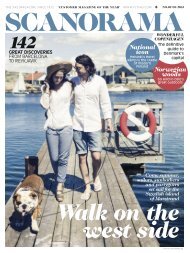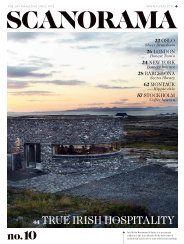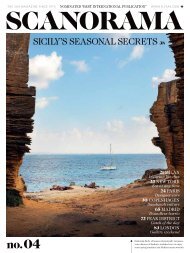Old school New England 92 - Scanorama
Old school New England 92 - Scanorama
Old school New England 92 - Scanorama
Create successful ePaper yourself
Turn your PDF publications into a flip-book with our unique Google optimized e-Paper software.
The trigger for this ice climbing trip was an invitation from the<br />
Norwegian alpine club “Norsk Tindeklub” to climb in the Lofoten<br />
islands. The offer to look for new lines together with some of the<br />
current best alpinists, like Marko Prezelj, Colin Haley, Aljaz Andere and<br />
many more, while at the same time being served fresh fish daily was<br />
just too attractive and I couldn’t resist.<br />
FROSTY START IN LAVANGEN<br />
Before heading to the important meeting at Lofoten, we wanted to search for<br />
some ice lines on the mainland, eastward of Narvik. On our arrival polar Norway<br />
sent us a cold welcome with -20 °C temperatures. Very close to Lavangenfjord<br />
the existing ice climbing area of Spansdalen is located. With uncountable<br />
possibilities at all grades, if you’re lucky you might even meet some other<br />
climbers here: normally an absolute rarity in Northern Norway.<br />
On the first day we looked for a line not too far from the road, because our<br />
bodies still felt the exhaustion of the journey. As usual in Northern Norway, the<br />
seemingly short approach turned out to be farther than it looked, and due to<br />
exhausting trailbreaking it took much longer than we estimated. At 5 p.m. it<br />
was dark, so already on our first day we had to use our headtorches.<br />
FROZEN BØNES – ONE DAY IN THE STORM<br />
After the cold start the next day we looked for a route in the sun. The famous<br />
and beautiful shaped “Flågbekken” WI5/6 in Salangen was the best choice at a<br />
still freezing -16 °C. The day after, we wanted to take a step in the direction of<br />
Sweden. We arrived in Bønes at -20 °C and with 80 km/h winds – ice climbing<br />
seemed to be impossible. But the cold air flow was only at the bottom of the<br />
valley. Higher up at the start of the route it was calm at a mere -8 °C. We<br />
managed to climb the great route, 250 metres on demanding ice around WI6<br />
X/R. When looking for a name for the route, “Frozen Bønes” was the only thing<br />
that came to my mind. Poor Hannes had to wait at the bottom of the valley with<br />
his telephoto lens in the storm and suffered frostbite on his nose.<br />
HAPPY END - SUMMIT OF HOVEN<br />
BIG DAYS IN SORDALEN<br />
The weather changed dramatically. The Gulf Stream had predominance now<br />
and the baltic -37 °C changed into +9 °C in the fjord on the next day. Now<br />
was the right time to start our activities in Sordalen. One perfect line after the<br />
other sprawl up to 700 metres over the steep granite face on the west slopes<br />
of the valley. On sight and totally clean we were able climb the routes “Stalker”<br />
700m WI6/M7 which is completely vertical over 300 metres of its length,<br />
and “Remember Mi” WI7-/M8, the ultimate fragile formation. These were two<br />
absolute highlights in our ice climbing career.<br />
LOFOTEN<br />
Driving to Kabelvåg took us eight hours longer than usual because of a strong<br />
storm. With 200 km/h wind speeds the Lofoten Islands were separated from<br />
the outside world. Heavy rain over three days and temperatures far above<br />
0 °C had a disastrous effect on the ice conditions on the islands that are well<br />
exposed to open sea. Nevertheless the climbers from all over the world were<br />
highly motivated. The strategy was quickly changed from ice climbing to winter<br />
climbing and we experienced some interesting days on the island in impressive<br />
surroundings.<br />
www.marmot.eu<br />
HANNES MAIR












